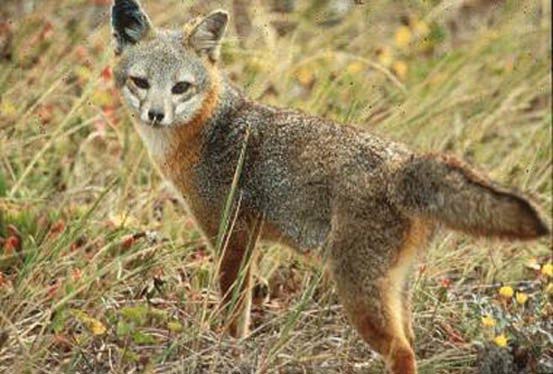The island gray fox, Urocyon littoralis is a little known beautiful fox. It is very fascinating as you will learn. This fox is also known by many other names, such as the short-tailed fox, dwarf fox, island fox, and most commonly, the Channel Island fox. There are six different subspecies which will be discussed later. The island gray fox is becoming increasingly endangered and there are many efforts to help save it.
*Photos from the Institute for Wildlife Studies and used with permission.
*THREATENED*
*SPECIES* *
*Why all the different names and subspecies?
Different names
The island gray fox is a little known fox that is becoming increasingly important and noteable. This fox is truly amazing. The name the island gray fox relates to how this species has evolved on islands from the mainland gray fox into its own species. The islands it lives on are six of the eight Channel islands of California. This is why it is commonly known as the Channel Island fox. It is known as the dwarf fox due to the fact that it is close to the smallest fox in the world, at 3-6 pounds, in a very close second to the fennec, at 3 pounds. The name small-tailed fox brings up a very interesting detail of the fox. This fox has two less vertabrae in its tail than any other fox.
Subspecies
The island gray fox has six subspecies, each on their different islands. On the Santa Catlina Island, it's subspecies Urocyon littoralis catalinae,the San Clemente Island fox is Urocyon littoralis clemente, on San Nicolas Island, it's the Urocyon littoralis dickeyi, the San Miguel Island, Urocyon littoralis littoralis, on the Santa Cruz Island lives Urocyon littoralis santacruzae and finally, the subspecies of the Santa Rosa Island is Urocyon littoralis santarosae.
Appearance and Physical Facts
The island gray fox is almost identical to the mainland gray fox in color. The differances are in the size and body proportion. The island gray fox is half the size of its mainland cousin. The proportions differ in its tail size, two vertebrae less than that other foxes, and it also has a slimmer muzzle than the mainland fox.  *
*
The fox can live up to ten years. During this time, they will find a partner and mate for life. The pair breed in winter and in April, they give birth to 2-5 tiny kits. Unfortunately, the foxes are extremely vulnerable to disease and are also easy prey for the golden eagles that inhabit the Channel Islands.
Character

Like most foxes, the island fox is omnivorous. It eats insects, mice and other small vertebrates, crabs, and fruit, but unlike most foxes, recent studies have shown that this fox may actually be active during the daytime, rather than being nocturnal.
Location
The island gray fox is native only to six of the eight Channel Islands off shore from California. The islands are Santa Catlina Island, San Clemente Island, San Nicolas Island, San Miguel Island, Santa Cruz Island, and the Santa Rosa Island. They are currently being raised in captivity and transported to other areas to try to raise their populations.
What Can You Do To Help?
The island gray fox is a unique species on the verge of extinction due to attacks by golden eagles and diseases from people's pets. Currently, they are being considered for the endangered species list. The National Park Foundation established the Island Fox Fund to help raise money and awareness of the fox. Most people don't even know this fox exsists. That has hindered the reestablishment of their populations.
So, what can you do to help? First, raise awareness of the island gray fox. Tell everyone who might be interested about animals or charity. If you wish to visit the Islands in hopes of seeing one of these beautiful, rare creatures yourself, officials say to please leave your pets at home. The foxes are dying off rapidly from diseases contracted from domestic animals. Even if your pet shows no sign of disease, it may still carry one and pass it on to the foxes. If you wish to donate to the Island Fox Fund, or learn more about them, visit the National Parks Island Fox page. Please, do what you can to help. This is a rare species that may soon be lost forever if we don't all pitch in to help.
**Photo by Tim Coonan and used with permission.
 **
**